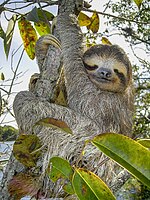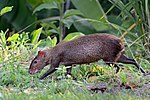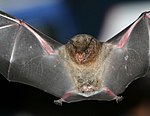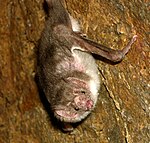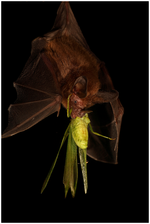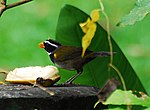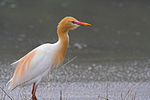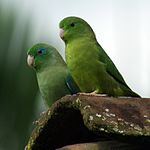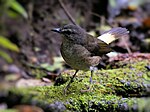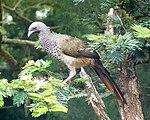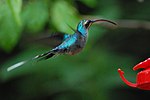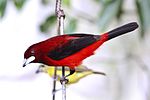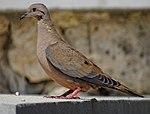geo.wikisort.org - River
Lebrija River is a river of northern Colombia. It originates in the Eastern Ranges of the Colombian Andes in Piedecuesta and flows through the northern part of the department of Santander into the Magdalena River in Puerto Wilches.
| Lebrija River | |
|---|---|
| Etymology | Antonio de Lebrija |
| Native name | Río Lebrija (Spanish) |
| Location | |
| Country | Colombia |
| Departments | |
| Provinces |
|
| Municipalities | |
| Physical characteristics | |
| Source | Eastern Ranges |
| • location | Piedecuesta |
| • coordinates | 7°05′59.1″N 73°00′55.1″W |
| • elevation | 2,532 m (8,307 ft)[1] |
| Mouth | Magdalena River |
• location | Loma de Corredor, Puerto Wilches |
• coordinates | 8°07′55.3″N 73°46′24.5″W |
• elevation | 41.1 m (135 ft)[1] |
| Basin size | 8,790 km2 (3,390 sq mi)[2] |
| Discharge | |
| • location | San Rafael |
| • minimum | 55.1 m3/s (1,950 cu ft/s)[3] |
| • maximum | 706 m3/s (24,900 cu ft/s)[4] |
| Basin features | |
| River system | Magdalena Basin Caribbean Sea |
Etymology
The Lebrija River is named after Antonio de Lebrija, the conquistador who discovered the river in 1529.
Description
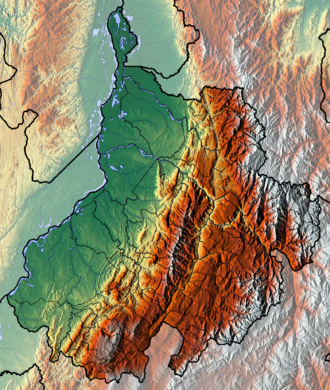
The Lebrija River originates at an altitude of 2,532 metres (8,307 ft) in the Eastern Ranges of the Colombian Andes to the northeast of Piedecuesta, Santander.[1] The Lebrija River, a confluence of the Suratá River and the Río de Oro,[5][6] flows northward through the municipalities Girón, capital of Santander Bucaramanga, Lebrija and Sabana de Torres to flow into the Magdalena River near the Loma de Corredor, Puerto Wilches,[7] Santander at an altitude of 41.1 m (135 ft).[1] In the lower course of the river, it forms the natural boundary between Santander and Cesar, close to the border with Bolívar. About 100 kilometres (62 mi) of the river, with a total basin size of 8,790 square kilometres (1.362×1013 sq in), is navegable.[2]
Geology
The type locality of the Girón Formation was identified along the Lebrija River in 1954.[8] At this type section, a total thickness of 4,650 metres (15,260 ft) of the formation was registered in 1968.[9] The type locality of the 1 kilometre (0.62 mi) thick La Paz Formation is also located near the river.[10]
Climate
The heavy rains over the capital district of Santander, the metropolitan area of Bucaramanga, have caused mortality of fish in the Lebrija River.[11] The Lebrija River transports an average of 4,739,000,000 cubic metres (1.674×1011 cu ft) of water per year.[12] The maximum discharge at the San Rafael station has been registered in December with 706 cubic metres per second (24,900 cu ft/s) and the minimum in January with 55.1 cubic metres per second (1,950 cu ft/s).[3][4] The higher basin of Lebrija Alto has between 66 and 2,065 millimetres (2.6 and 81.3 in) of precipitation per year in a bimodal pattern. The rainy seasons are March to May and September to November with drier periods from December to February and June to August. The temperature ranges from 0 and 35 °C (32 and 95 °F), the relative humidity reached 81% and the hours of sunshine vary between 1472 and 1913.[13]
Flora and fauna


Many species of flora and fauna have been registered in the Lebrija River basin. A total number of 761 species of which 172 birds, 77 insects, 124 mammals, 104 fish and 284 plant species have been noted at Rionegro, Santander.[14] The Cerulean Warbler Bird Reserve is close to the Lebrija River in Bucaramanga.[15]
Flora
The following species and genera are noted in the upper part of the Lebrija River: Ocotea sp., Miconia sp., Guarea grandifolia, Hedyosmum bomplandianum, Guateria sp., Protium sp., Ochroma sp., Piper sp., Trema micrantha, Vismia baccifera, Urera caracasana, Cecropia sp. and Croton leptostachis.[16]
Fauna
Mammals
The following mammals have been registered in the upper and central Lebrija River basins:[14][16][17]
Amphibians and reptiles
The following species have been registered in the central Lebrija River basin:[14]
Birds
The following species have been registered in the central Lebrija River basin:[14]
Fish
The following species have been registered in the central Lebrija River basin:[14]
| Name | Species | Image |
|---|---|---|
| guppy | Poecilia reticulata |  |
| redhump eartheater | Geophagus steindachneri |  |
| wolf fish | Hoplias malabaricus |  |
| Prochilodus magdalenae |  | |
| Sturisomatichthys leightoni |  | |
| Cauca molly | Poecilia caucana | |
| Astroblepus homodon | ||
| Leporinus muyscorum | ||
| Ancistrus caucanus | ||
| Astynax magdalenae | ||
| Brycon henni | ||
| Chaetostoma fischeri | ||
| Chaetostoma milesi | ||
| Gephyrocharax melanocheir | ||
| Hemibrycon dentatus | ||
| Hypostomus hondae | ||
| Ichthyoelephas longirostris | ||
| Parodon magdalenensis | ||
| Pimelodus blochii | ||
| Pimelodus grosskopfii | ||
| Rhamdia quelen | ||
| Roeboides dayii | ||
| Salminus affinis | ||
Trivia
- In 1898, Princess Theresa of Bavaria made the first reported finding of an egg of the Magdalena River turtle (Podocnemis lewyana) near the Lebrija River[18]
See also
References
- Google Maps Elevation Finder
- GIDROT, 2011, p.128
- GIDROT, 2011, p.118
- GIDROT, 2011, p.119
- GIDROT, 2011, p.144
- CIAT, s.a., p.21
- CDIM, s.a., p.5
- GIDROT, 2011, p.44
- GIDROT, 2011, p.45
- GIDROT, 2011, p.59
- (in Spanish) El Río Lebrija pierde sus peces - El Espectador
- GIDROT, 2011, p.117
- CDMB, s.a., p.4
- (in Spanish) Fauna y flora de la cuenca media del Río Lebrija en Rionegro, Santander - Humboldt Institute
- Cerulean Warbler Bird Reserve - ProAves
- CDMB, s.a., p.9
- CDMB, s.a., p.10
- Castaño Mora, 1986, p.666
Bibliography
- Castaño Mora, Olga Victoria. 1986. Contribución al conocimiento de la reproducción de Podocnemis lewyana (Reptilia: Quelonia: Pelmedusidae). Caldasia, Universidad Nacional de Colombia XV. 665-667. Accessed 2017-03-11.
- GIDROT, _. 2011. Santander 2030 - Diagnóstico dimensión biofísico ambiental territorial de Santander, 1-250.Universidad Industrial de Santander. Accessed 2017-03-11..
- N., N. s.a. Aspectos del medio natural, 1-32.CIAT. Accessed 2017-03-11..
- N., N. s.a. Plan de ordenamiento y manejo ambiental subcuenca Lebrija Alto, 1-121.CDMB. Accessed 2017-03-11..
- N., N. s.a. Sistema hidrográfico municipio de Barrancabermeja, 1-39.CDIM. Accessed 2017-03-11..
Further reading
- McNally, Rand. 1993. The New International Atlas, 1-560.Rand McNally. Accessed 2017-03-11..
- IDEAM, _. 2001. Geomorfología y susceptibilidad a la inundación del Valle fluvial del Magdalena - sector Barrancabermeja - Bocas de Cenizas, 1-58.IDEAM. Accessed 2017-03-11..
Другой контент может иметь иную лицензию. Перед использованием материалов сайта WikiSort.org внимательно изучите правила лицензирования конкретных элементов наполнения сайта.
WikiSort.org - проект по пересортировке и дополнению контента Википедии














